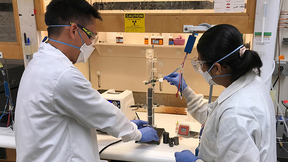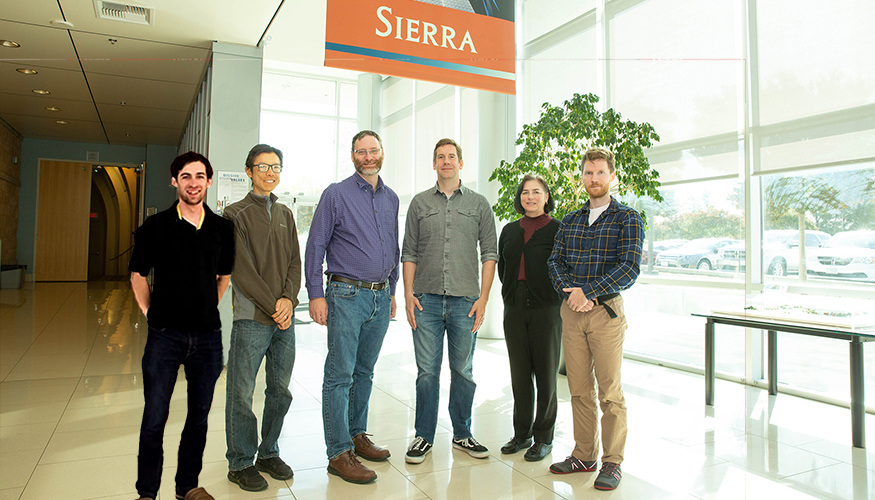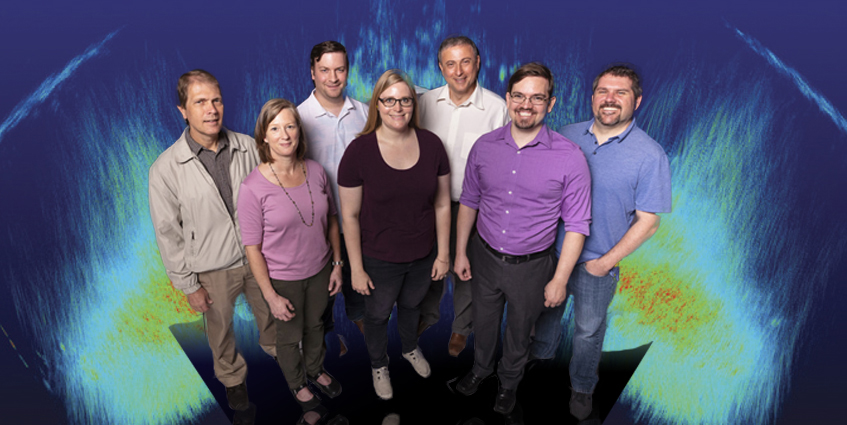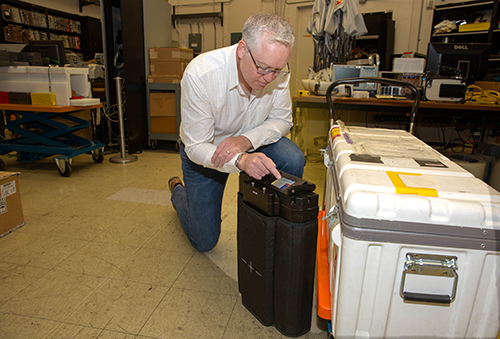LLNL researchers win four R&D 100 awards
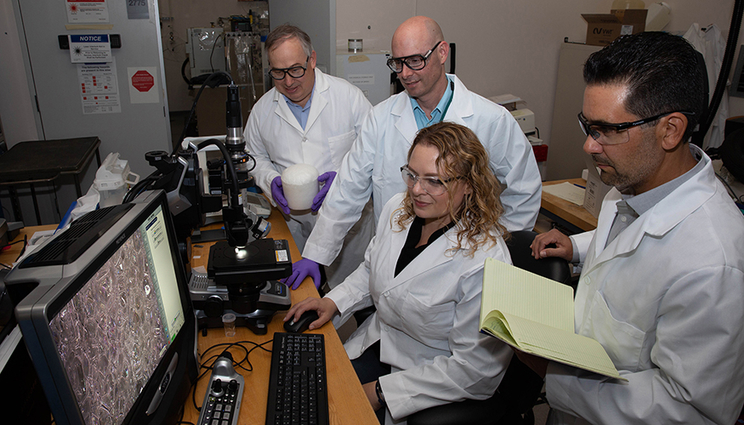 (Download Image)
(Download Image)
Researchers from LLNL, Shape Memory Medical Inc. and Texas A&M University have developed the IMPEDE embolization plug, a medical device that prevents continued blood flow to diseased vessels. Members of the LLNL team include Jennifer Rodriguez, who is checking a test sample microstructure from a shape memory polymer, while (left-to-right) Tom Wilson, holding a billet of shape memory polymer foam, Ward Small and Jason Ortega watch. Photos by Julie Russell/LLNL.
Lawrence Livermore National Laboratory (LLNL) researchers have garnered four awards among the top 100 industrial inventions worldwide.
The trade journal R&D World Magazine announced the winners of the annual awards, sometimes called the “Oscars of invention,” in an online post and emails to winners.
The awards will be presented Dec. 5 during the 57th annual program, a black-tie gala at the San Mateo Marriott. With this year’s results, the Laboratory has now captured a total of 169 R&D 100 awards since 1978.
This year’s winners include: Spack, a software package management tool for high-performance computing applications; IMPEDE, a medical device that reduces blood flow to blood vessels outside of the brain to decrease health risks; the Scalable Checkpoint/Restart Framework 2.0 (SCR), a software package that allows high-performance computing simulations to take advantage of hierarchical storage systems; and the MC-15 Portable Neutron Multiplicity Detector, an instrument that can quickly identify and assess nuclear-based threats.
Spack won two awards – an R&D 100 and a special recognition medal in the “market disruptor” category.
Two of LLNL’s four R&D 100 awards – for IMPEDE and the SCR – received internal “seed money” from the Laboratory Directed Research and Development (LDRD) program. This funding enables undertaking high-risk, potentially high-payoff projects at the forefront of science and technology.
“These awards recognize the incredible value our national laboratories deliver in the form of groundbreaking ideas that, if successful, stand to transform how we live our lives,” said U.S. Secretary of Energy Rick Perry. “We are enormously proud of our labs’ ability to continually redefine what’s possible, helping to ensure a more prosperous and secure future for our nation.”
LLNL Director Bill Goldstein noted: “Our talented and dedicated researchers apply themselves to solving some of today’s most challenging problems. These awards serve as recognition that their innovative work has a deep impact on industry, our nation and the world.”
Speeds software builds
Spack is an easy-to-use, versatile and scalable software package management tool for high-performance computing (HPC) applications. It simplifies and accelerates building and customizing software by automating the build workflow, thus reducing deployment time for large software stacks from weeks to hours.
In 2013, Todd Gamblin, an LLNL computer scientist, created the first prototype of Spack to automate the many tedious software builds he and colleagues were forced to perform manually.
Today, Spack is widely available as open-source software. Spack’s original 100 or so packages have grown into a library of more than 3,500, and a large and active community of more than 450 contributors regularly adds features and improvements.
Spack is now used for software deployment on six of the world’s top 10 supercomputers and it has been adopted by a number of HPC centers and software development communities.
A team of LLNL researchers led the development of Spack, a software package management tool for high-performance computing applications. The software was co-developed by 13 other universities, national labs, institutes and computing centers. Shown from left are: Greg Becker, Greg Lee, Matt Legendre, Todd Gamblin, Tammy Dahlgren and Peter Scheibel.Even outside of HPC centers, Spack has had a major impact. It has been picked as an end-to-end development tool within the high-energy physics community, based at Femilab in the U.S. and CERN (the European Organization for Nuclear Research) in Switzerland.
The Livermore Spack team is led by Gamblin and includes computer scientists Greg Becker, Tamara Dahlgren, Gregory Lee, Matt Legendre and Peter Scheibel.
While LLNL led the initial development of Spack, the software’s co-developers include: Argonne National Laboratory; Columbia University; École Polytechnique Fédérale de Lausanne; Fermi National Accelerator Laboratory; Iowa State University; Kitware, Inc.; NASA Goddard Institute for Space Studies, the Center for Climate Systems Research; the National Energy Research Scientific Computing Center; Perimeter Institute; the University of Hamburg; the University of Illinois at Urbana–Champaign; and the University of Iowa.
See more information about Spack.
Medical device aids healing
Researchers from LLNL, Santa Clara-based Shape Memory Medical Inc. and Texas A&M University have developed the IMPEDE embolization plug, a medical device that prevents continued blood flow to diseased vessels.
IMPEDE, which has been cleared by the Food and Drug Administration for use in the U.S. and has been cleared for use in Europe, reduces the blood flow through diseased or damaged vessels that can occur in abdominal aortic aneurysm endoleaks, gastric and esophageal varices or blunt trauma.
Continued blood flow to diseased vessels can have major consequences, such as severe pain, excessive blood or even death in the worst circumstances.
The IMPEDE device offers 100-1,000 times greater surface area than current technologies to more effectively initiate clotting in the target vessel and divert blood flow away from at-risk regions.
To date, more than 250 patients have been successfully treated worldwide with IMPEDE for conditions such as deformed arteries, tumor resections (where blood flow has been blocked to tumors) and pelvic congestion syndrome, with no reported adverse effects.
Work on the technology started at LLNL nearly 20 years ago under Duncan Maitland, who left the Lab in 2007 for Texas A&M University, where he is an associate department head in the Department of Biomedical Engineering.
Lab employees who have worked on the project include polymer scientist Tom Wilson, biomedical engineer Jennifer Rodriguez, applied optical physicist Ward Small and computational fluid dynamics engineer Jason Ortega.
Software improves performance
A team of computer scientists from LLNL, with support from Argonne National Laboratory, has developed software – the Scalable Checkpoint/Restart Framework 2.0 (SCR) – that enables HPC simulations to take advantage of hierarchical storage systems without complex computer code modifications.
Using SCR, the input/output performance of scientific simulations can be improved by hundreds of times, with the results produced in significantly less time than they could be with traditional methods.
This is important because HPC applications simulate real-world phenomena that impact people’s daily lives. For example, the results of models that predict the behavior of hurricanes are used by policymakers to make important decisions about where and when to evacuate people. Scientific simulations can require hours, days or even weeks to compute, so delays in obtaining the results can create problems.
A team of LLNL computer scientists has developed software – the Scalable Checkpoint/Restart Framework 2.0 (SCR) – that enables high-performance computing simulations to take advantage of hierarchical storage systems without complex computer code modifications. Some of the team members are (from left): Bronis de Supinski, Kathryn Mohror, Tony Hutter, Elsa Gonsiorowski, Greg Kosinovsky, Cameron Stanavige and Adam Moody. The background graphic shows a volume visualization of the stimulated Raman scatter light in a laser-plasma interaction, which was one of the first application codes aided by SCR.Through the years, supercomputers have increased in computing power, largely by increasing the number of processors. The larger scale allows researchers to simulate larger and more complex problems or to compute existing problems much faster. Unfortunately, the larger the scale of the HPC application run, the greater the challenges for input/output.
With traditional methods, documented cases report applications losing as much as half of their run time due to input/output and other problems. With SCR, researchers can get their results without major delays or major code changes.
The LLNL SCR team includes computer scientists Adam Moody, Kathryn Mohror, Bronis de Supinski, Gregory Becker, Kathleen Shoga, Cameron Stanavige, Greg Kosinovsky, Tony Hutter and Elsa Gonsiorowski; and former Lab employees Tanzima Islam, Kento Sato, Raghunath Chandrasekar and Greg Bronevetsky.
Detecting nuclear threats
Scientists from Livermore, Los Alamos and Sandia national laboratories have developed an instrument to help emergency response teams quickly identify and assess nuclear threats.
The instrument, known as the MC-15 Neutron Multiplicity Detector, uses the technique of neutron multiplicity to measure the quantity and determine the arrangement of any special nuclear material (SMN) like plutonium and uranium.
The defining quality of SNM is the ability to sustain a fission chain. Fission chains result when neutrons from one fission bump into other nuclei and induce them to fission.
Scientists from Livermore, Los Alamos and Sandia have developed the MC-15 Neutron Multiplicity Detector to help emergency response teams rapidly identify and assess nuclear threats. Lab physicist Sean Walston, one of two LLNL employees who worked on the project, is shown with one of the instruments.The neutrons that result from a fission chain come out closely spaced in time. They are correlated in time in much the same way raindrops are correlated in time with thunderstorms. Neutrons from SNM arrive in bursts separated by gaps, where periods of time pass with few or no counts. The characteristics of the SNM can be determined from this pattern of neutron arrival times.
The MC-15 does not simply record that a neutron was counted, but also when. It records neutron detections with a time resolution of 100 billionths of a second, approximately the characteristic time scale of a fission chain. It can operate with count rates of less than one count per second to more than 100,000 counts per second.
The MC-15 is portable, weighs 47 pounds, is superior in a number of ways to previous neutron multiplicity detectors and requires relatively little training to operate.
Two LLNL physicists collaborated on the MC-15’s development, Sean Walston and Dan Dietrich, who is now retired.
Contact
 Stephen Wampler
Stephen Wampler
[email protected]
(925) 423-3107
Related Links
LLNL Innovation and Partnerships OfficeR&D World Magazine
Tags
Economic ImpactIndustry Collaborations
Technology Transfer
Featured Articles

